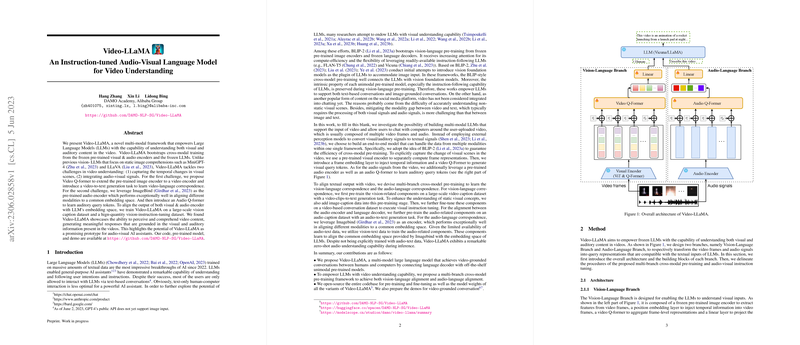Overview of Video-LLaMA: An Instruction-tuned Audio-Visual LLM for Video Understanding
The paper "Video-LLaMA: An Instruction-tuned Audio-Visual LLM for Video Understanding" introduces an innovative framework that empowers LLMs to understand and process both visual and auditory content in videos. The work, authored by Hang Zhang, Xin Li, and Lidong Bing from DAMO Academy and Hupan Lab, explores the challenges and solutions for achieving comprehensive video comprehension using multi-modal LLMs.
Key Contributions
The primary contributions of Video-LLaMA are multifaceted:
- Multi-modal Framework: Video-LLaMA introduces a comprehensive framework that integrates visual and auditory content processing into LLMs. This is distinct from previous works that focus solely on either visual or auditory signals.
- Video Q-former and Audio Q-former: The paper presents innovative components such as the Video Q-former and Audio Q-former, which facilitate the generation of query embeddings for the LLM from video frames and audio segments respectively.
- Cross-modal Pre-training: The model employs a two-stage training process. First, large-scale video/image-caption pairs are used for pre-training, followed by fine-tuning on high-quality visual-instruction datasets to align both vision-language and audio-language modalities with the LLM's embedding space.
- Open-Source Commitment: The authors provide the entire codebase for pre-training and fine-tuning, as well as the model weights for various Video-LLaMA variants, thus contributing to the open-source community.
Methodology
The architecture of Video-LLaMA is divided into two main branches: the Vision-Language Branch and the Audio-Language Branch.
- Vision-Language Branch:
- Utilizes a pre-trained image encoder to extract features from video frames.
- Positional embeddings are applied to incorporate temporal information.
- Video Q-former aggregates frame-level representations to generate video query tokens.
- A linear layer projects these tokens to the same dimension as the LLM text embeddings for multi-modal integration.
- Audio-Language Branch:
- Employs a pre-trained audio encoder, specifically ImageBind, to generate dense vectors representing audio segments.
- Similar to the Vision-Language branch, the Audio Q-former and a linear layer map these audio embeddings into the LLM space.
- Temporal information is injected through position embeddings, ensuring synchronization with video frames.
Training Procedure
The training process for Video-LLaMA involves:
- Vision-Language Pre-training: Utilizes datasets such as Webvid-2M and CC595k for large-scale pre-training. This stage emphasizes the extraction of visual knowledge from video frames and static images.
- Instruction Fine-tuning: Involves high-quality datasets from MiniGPT-4 and LLaVA, focusing on refining the model’s ability to follow instructions and comprehend both static and dynamic visual inputs.
- Audio-Language Adaptation: Given the scarcity of audio-text datasets, the model leverages visual-text data during pre-training. ImageBind’s shared embedding space enables the model to map audio features to the LLM’s space effectively.
Comparative Analysis and Implications
The paper provides a comparative analysis (see Table 1) which highlights Video-LLaMA's unique capability to understand both visual and auditory content, setting it apart from existing multi-modal LLMs like BLIP2, MiniGPT4, and AudioGPT. This dual comprehension ability opens new avenues for developing more interactive and perceptive AI systems, particularly in applications requiring multi-modal inputs such as video analysis, augmented reality, and intelligent virtual assistants.
Theoretically, Video-LLaMA bridges a significant gap in the integration of multi-modal signals, marking progress towards holistic video understanding. Practically, its potential applications range from enhancing human-computer interaction to improving accessibility features in multimedia content.
Future Developments
Looking forward, several aspects could be further explored:
- Enhanced Dataset Quality: Building high-quality, large-scale audio-video-text alignment datasets could significantly improve the model's perceptual abilities.
- Scalability and Efficiency: Addressing the computational challenges associated with processing long videos remains an open research question.
- Hallucination Mitigation: Tackling the LLM-inherited issue of hallucination would be crucial for enhancing the model's reliability and accuracy.
In conclusion, Video-LLaMA represents a significant advancement in the field of multi-modal LLMs, demonstrating the feasibility and benefits of integrating auditory and visual signals for video understanding. Its open-source availability facilitates further research and development, promising future improvements and applications in the field of AI.
